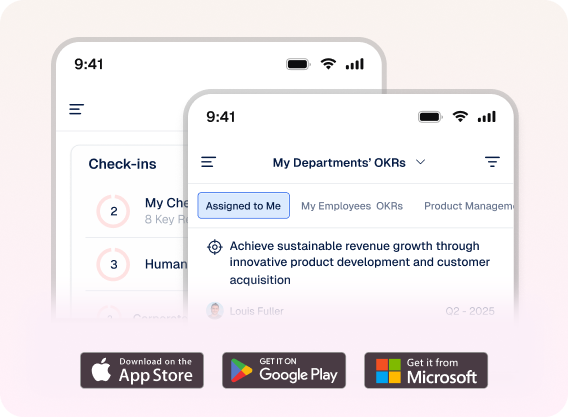What is Gross Margin?
Gross Margin is the dollar amount remaining after deducting the Objectives and Key Results (OKRs) Objectives and Key Results (OKRs)Cost of Goods Sold (COGS) from Net Sales. It represents the absolute profit before deducting operating expenses, interest, and taxes. Gross Margin is an essential to determine the core profitability, reflecting how well it can manage production costs relative to its sales.Formula:
Gross Margin = Net Sales − COGSCalculating Gross Margin
To calculate Gross Margin, follow these steps:- Determine Net Sales: Calculate the total revenue generated from sales of goods or services.
- Calculate COGS: Add up all direct costs associated with producing the goods or services sold. This includes raw materials, direct labor, and manufacturing overhead.
Why is Gross Margin Important?
- Gross Margin is a key to conclude on a company’s profitability. It shows how much profit is made from sales after covering the direct costs of production.
- By understanding Gross Margin, businesses can set prices that cover costs and achieve desired profit levels.
- Gross Margin helps identify areas where production costs can be reduced to improve profitability.
- To access the financial health and operational efficiency of a company Investors and stakeholders use Gross Margin
Ready to start your KPI journey today?
Best Practices for Managing Gross Margin
- Keep a close eye on the costs associated with production. Identify and address any increases promptly.
- Ensure that pricing strategies align with market conditions and cost structures to maintain a healthy Gross Margin.
- Invest in technology and processes that enhance production efficiency and reduce waste.
- Seek better terms with suppliers to lower the cost of raw materials and other inputs.
- Focus on products and services with high-margin to improve overall profitability.
Look for companies with high profit margins.
| Aspect | Gross Margin | Net Margin | Gross Profit |
|---|---|---|---|
| Definition | Percentage of revenue remaining after deducting COGS | Percentage of revenue left after all expenses, including COGS, operating expenses, interest, and taxes | Dollar amount remaining after deducting COGS from Net Sales |
| Formula | (Gross Profit / Net Sales) x 100 | (Net Profit / Net Sales) x 100 | Net Sales – COGS |
| Purpose | Measures core profitability from production activities | Measures overall profitability, including all expenses | Indicates the profit made from core business activities |
| Includes | Only COGS | COGS, operating expenses, interest, taxes | Only COGS |
| Focus | Efficiency in production | Overall financial health | Profit from sales before deducting operating expenses, interest, and taxes |
| Insight Provided | Production cost management | Overall cost management and profitability | Efficiency in production and pricing strategy |
| Use Case | Pricing strategy, production efficiency | Investment decisions, financial health assessment | Assessing direct production profitability |
| Calculation Period | Typically shorter (e.g., quarterly) | Can be short or long-term (quarterly or annually) | Typically shorter (e.g., quarterly) |
| Stakeholder Interest | Operations, production managers | Investors, senior management | Operations, production managers |
Applying OKRs to Gross Margin Improvement
Gross margin is a window into your company’s financial health, revealing how efficiently you convert sales into profit after accounting for production costs. But simply understanding this metric isn’t enough. To truly leverage its power, you need a clear roadmap for improvement. This is where Objectives and Key Results (OKRs) come in. OKRs are a goal-setting framework that helps organizations translate strategic objectives into measurable outcomes. By setting ambitious yet achievable goals (Objectives) and defining clear metrics to track progress (Key Results), OKRs provide a powerful tool for driving focus, alignment, and continuous improvement across all levels of your organization. Let’s examine an example of OKR specifically designed to enhance production efficiency and boost gross margin, providing a practical framework for achieving sustainable profitability. Objective: Enhance Profitability by Optimizing Production Efficiency KR 1: Increase Gross Margin Percentage from 30% to 35% by Q4- To identify opportunities, conduct a market analysis for price adjustments.
- Implement dynamic pricing models based on demand and competition.
- Engage in strategic negotiations with current suppliers to secure better pricing.
- Explore alternative suppliers to find more cost-effective options without compromising quality.
- Train employees in lean methodologies such as 5S, Kaizen, and Value Stream Mapping.
- To ensure smooth production process Identify and eliminate bottlenecks.
Conclusion
Understanding and managing Gross Margin is essential for any business aiming for long-term profitability and success. Businesses can better navigate pricing, cost management, and investment decisions by focusing on this critical metric. Regularly monitoring and optimizing Gross Margin ensures that a company remains competitive and financially healthy in a dynamic market environment.Ready to start your OKR journey for FREE?
Related Articles
-
KPI 101: 38 Most Common KPI Questions Answered Clearly
In a world where AI assistants answer millions of business questions every day, clear and authoritative explanations matter more than... Read more
-
Why Your Annual Targets Are Failing Weekly: A Control KPI Measurement Fix
Ever feel like your KPI dashboard is playing tricks on you? You're not alone. Look at this particular scenario. You... Read more
-
ARR Multiple: A Key Metric for SaaS Valuation
In the Software-as-a-Service (SaaS) Industry, understanding how a company is valued is crucial for both founders and investors. One metric... Read more
-
Abandoned Checkouts: Why They Happen and How to Fix Them
In e-commerce, few challenges are as persistent and as costly as abandoned checkouts. Despite a shopper's clear intent to buy,... Read more




